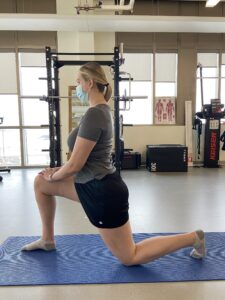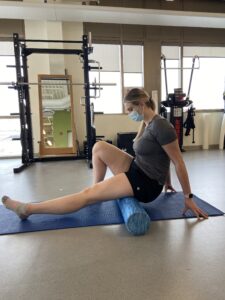Feeling tight lately? Noticing more stiffness or difficulty performing certain movements? Feels like visiting your physiotherapy clinic in Edmonton? Let’s talk about it!
What is flexibility?
- “Flexibility” describes the total range of motion a joint or body segment can move within each plane of motion. In other words, it’s how much movement you can achieve around a joint without experiencing pain or resistance. Not only is our flexibility an important indicator of our muscle and joint health, but it also serves as a critical foundation for our body to perform our daily activities.
- Optimal flexibility of a joint is a combination of normal extensibility of both the muscles and soft tissue around a joint; as well as normal mechanics of the joint surfaces themselves. Many other factors contribute to flexibility as well, including but not limited to age, gender, scar tissue, joint adhesions, or injury (Anderson &Parr, 2013).
Why is my flexibility important to improve?
- A flexibility program can help you feel better and experience less stiffness, improve and correct your posture, reduce your risk of injuries and reduce the development of chronic conditions.
- If a joint or segment of the body is ‘hypomobile,’ meaning, flexibility in the area is reduced, this may increase your risk to experience injury. Namely, muscular strains, overuse injuries (ie. Tendinopathies), or nerve compression conditions may be experienced as a result.
- Since the human body is a chain, limited movement in one area will directly affect the joints and limbs immediately adjacent to it. Therefore, a hypomobility in one joint or area may lead to overloading or a “hypermobility” around it as the body has to compensate for the loss of motion over time. Further, changes in tissue length and joint mobility may also cause changes in posture contributing further to the risk of injury development or symptoms.
5 Quick Ways to Improve your Flexibility:
1. Daily Stretching
- Passive stretching is one of the most well-known techniques to address muscular tension and has been shown as one of the most effective treatments in research.
- Stretching typically involves moving to the end of the available motion and maintaining a prolonged hold (20 – 30 sec) with slight overpressure as to feel a stretch or tension within the muscle.
- For best and enduring results, it is important to stretch daily. The goal is to total 60 seconds of stretch to each affected muscle. How many repetitions you utilize to achieve this total can be individualized to your tolerance but is typically recommended within 2 – 3 repetitions (20 – 30 seconds each).
- It is important to note that you should not feel any pain during a stretch. If pain is experienced, it may be an indicator you are stretching too far or to see a physiotherapist for a thorough assessment.
- A gentle warm-up or heat application (if appropriate) to the area prior to stretching can improve results and effectiveness.



Figure 1: Demonstrations of common lower extremity stretches for the hamstrings, hip flexor, and glutes, respectively.
2. Active (AROM) vs. Active-Assisted (AAROM) Range of Motion Exercises
- Following static stretching, it’s important to move your joint and musculature through the new range you have just created. By following your stretches with AROM/AAROM exercises, this facilitates muscular strengthening within the new range and further joint lubrication to maintain the improvement achieved by stretching.
- To perform AROM exercises, you will focus on moving the joint throughout the total pain-free range of motion for 15 repetitions. Focus on holding at the new end range for 2 – 3 seconds.
- For a deeper stretch, active-assisted ROM exercises utilize belts, brooms, or hockey sticks to achieve further stretch into end range. It is important to perform these exercises slowly and with control.
3.Self-Myofascial Release (SMR) Techniques
- Self-myofascial release techniques are strategies to massage or release trigger points on your own. Foam rollers, massage balls, or massage wands can be used to release tension within the muscle and aid with your flexibility training.
- Although research is presently unclear on the exact mechanism that causes the effect, one thing is of agreeance, these techniques are an effective adjunct to stretching and range of motion exercises when the goal is to improve flexibility.
- It is recommended to roll over the affected muscle / area for 30 – 60 seconds, allowing yourself to pause on particularly tight areas noticed throughout the repetition. This can be repeated for up to 3 repetitions, allowing yourself a 30 second rest in between.
- It’s important to note that SMR is considered an ‘adjunct’ technique and therefore is only beneficial when used in combination with stretching and range of motion exercises.

Figure 3: Trigger point release / self-myofascial massage for the hamstrings with a foam roller.
4.Deep Breathing / Relaxation Techniques
- Stress is often an unavoidable factor of our day-to-day lives and it may be affecting your flexibility more than you think. Psychological stress has been shown to increase muscular activity and tension at rest.
- Stress and cortisol (the stress hormone) naturally causes an increase in the activity of your sympathetic nervous system triggering your ‘fight-or-flight’ responses. This system inherently triggers an increase in tone throughout your muscular system.
- Deep breathing and relaxation techniques can be used to decrease the activity of our sympathetic nervous system and to instead activate our ‘rest-and-digest’ system, the parasympathetic nervous system, promoting relaxation throughout the body.
- Deep breathing exercises, especially practicing diaphragmatic breathing, can be done in sitting or laying on your back. Place one hand on your chest and one hand on your belly. While inhaling through your nose, count to 2 and focus on feeling your belly rise. Hold for 2 counts. Finally, exhale through your pursed lips for 4 counts. Repeat for 10 cycles!
- This pattern of breathing naturally causes your body to release tension and stress and can make your stretching activities more effective and prevent further stiffening over time!
5.Stay Active and Take Stretching Breaks!
-
- Moving your body is one of the best ways to address and prevent stiffness. Physical activity has many benefits, including increasing blood flow, improving muscular extensibility, relieving stress, allowing for joint lubrication, and improving posture.
- Try to take activity or stretching breaks throughout your day, especially to break up long periods of time spent in one position (i.e sitting). Breaking up static postures can help prevent the development of muscle tightness, joint stiffness, and counteract the effects of habitual postures.
- Short activity breaks, even 30 – 60 seconds of stretching every hour can dramatically improve your flexibility and help maintain your range of motion.
-
- Consistency is key!
When to see a physiotherapist:
While flexibility training can often be performed at home, others prefer to have it at a physiotherapy clinic in Edmonton. It is important to ensure these exercises are safe and appropriate for you and your body. A thorough assessment with a physiotherapist can help you identify both physical and environmental factors contributing to your flexibility and tailor these quick steps to your specific area of concern. Further, a holistic assessment will include important safety screening to minimize your risk of injury during your rehabilitation. Lastly, if you’ve tried these steps and have not seen any improvements in your range of motion, a physiotherapist can help you detect and treat any underlying joint pathologies contributing to your restrictions that are difficult to treat at home or may be limiting your progress. Come visit our team of health care professionals at Advantage Sports medicine for an assessment and to get back to doing what you love.
References:
| Alter, M. J. (2004). Science of flexibility. Human Kinetics. | |
| Behm, D. G., & Wilke, J. (2019). Do self-myofascial release devices release myofascia? Rolling mechanisms: a narrative review. Sports Medicine, 49(8), 1173-1181.
Dębski, P., Białas, E., & Gnat, R. (2019). The parameters of foam rolling, self-myofascial release treatment: a review of the literature. Biomedical Human Kinetics, 11(1), 36-46. Peacock, C. A., Krein, D. D., Silver, T. A., Sanders, G. J., & Von Carlowitz, K. P. A. (2014). An acute bout of self-myofascial release in the form of foam rolling improves performance testing. International journal of exercise science, 7(3), 202.Chicago Stathokostas, L., Little, R., Vandervoort, A. A., & Paterson, D. H. (2012). Flexibility training and functional ability in older adults: a systematic review. Journal of aging research, 2012. |
|
Wilke J, Müller AL, Giesche F, Power G, Ahmedi H, Behm DG. Acute Effects of Foam Rolling on Range of Motion in Healthy Adults: A Systematic Review with Multilevel Meta-analysis. Sports Med. 2020 Feb;50(2):387-402. doi: 10.1007/s40279-019-01205-7. PMID: 31628662.
